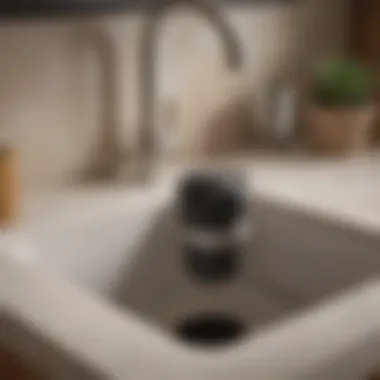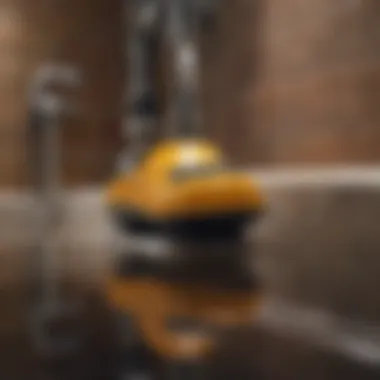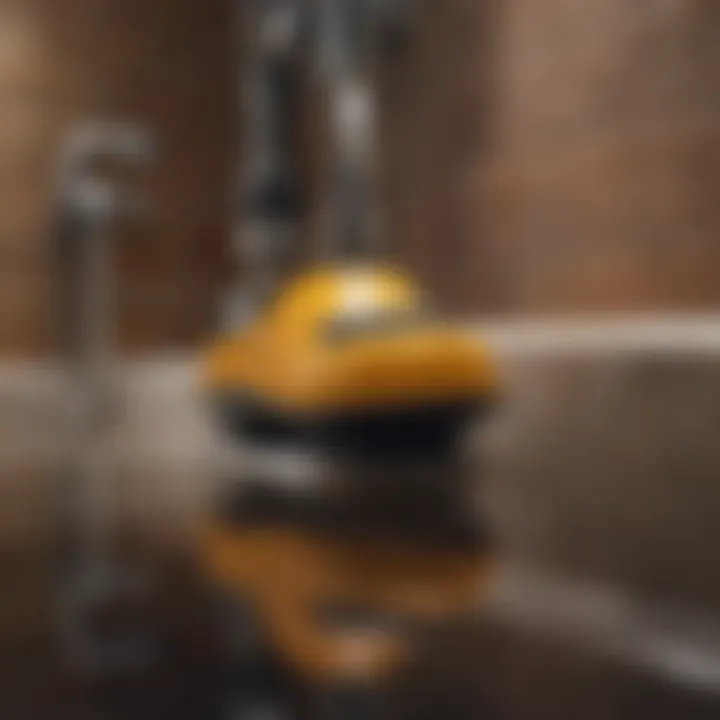Unclog Your Drain Effectively with Garbage Disposal


Intro
Clogged drains are a common issue in homes, often leading to frustrating situations. One effective tool to resolve these problems is the garbage disposal. Understanding how to effectively utilize this appliance can help homeowners tackle clogs before they escalate into bigger plumbing issues. This article offers practical insights into the mechanics of garbage disposals, types of clogs, preventive measures, and maintenance tips. With the right approach, one can ensure that the kitchen plumbing system operates smoothly, avoiding the costly expenses of plumbing services.
Understanding Garbage Disposals
How Garbage Disposals Work
Garbage disposals are designed to grind food waste into small particles, which are then flushed down the drain with water. Typically, they consist of a motor, grinding chamber, and grinding plate. When powered on, the motor turns the grinding plate, allowing food waste to be ground with the aid of water. This process prevents organic matter accumulation in drains.
Benefits of Using a Garbage Disposal
Utilizing a garbage disposal offers several advantages. Some of these benefits include:
- Reduced kitchen waste: Disposals help to minimize trash, making kitchen clean-ups faster.
- Prevent drain clogs: Food particles are ground into small bits, helping to prevent larger clogs in plumbing.
- Odor reduction: Regular use of the disposal helps manage smells associated with decomposing food waste.
Common Causes of Clogs
Clogs can occur even with a functioning garbage disposal. Several factors can contribute to drain blockages:
- Large food particles: Putting too much food waste at once can overwhelm the disposal.
- Fibrous vegetables: Foods like celery or corn husks can get tangled in the blades, causing jams.
- Grease: Pouring fat or oil can lead to buildup in pipes, resulting in clogs over time.
Prevention Techniques
Preventive measures can significantly reduce the likelihood of clogs. Here are some strategies to consider:
- Dispose in small amounts: Introduce food waste gradually to avoid overloading the disposal.
- Use cold water: Running cold water while grinding helps solidify grease, preventing buildup.
- Regular maintenance: Keep your disposal clean with regular maintenance practices to avoid odors and clogs.
Troubleshooting and Repairs
If you encounter a clog, it is important to know how to troubleshoot the situation.
- Check for power: Ensure the garbage disposal is plugged in and the circuit breaker has not tripped.
- Use the reset button: Locate the red reset button on the disposal and press it, which might solve the problem.
- Inspect the drain: Use a flashlight to look for visible blockages in the disposal or the pipes.
Maintenance Tips
Proper maintenance is essential for a long-lasting garbage disposal.
- Run it regularly: Use your disposal frequently to prevent rust and corrosion.
- Clean it regularly: Use a mixture of ice and salt to clean the grinding chamber, improving efficiency.
- Avoid harsh chemicals: Steer clear of chemicals that can harm the disposal or pipes.
Incorporating these practices can extend the life of your disposal and ensure it functions well.
Epilogue
Understanding how to unclog drains effectively with a garbage disposal can save time and money while maintaining kitchen hygiene. Regular monitoring, proper usage, and maintenance are key aspects of preventing and addressing clog-related issues. With attention and care, homeowners can enjoy the benefits of a smoothly operating kitchen drainage system.
Understanding Garbage Disposals
Garbage disposals play an essential role in managing kitchen waste. Their function improves the overall efficiency of a kitchen by minimizing the bulk of biodegradable material. Understanding how garbage disposals work allows homeowners to leverage their advantages fully while avoiding common pitfalls like clogs. The significance of this topic lies in recognizing the device as not just a disposal method but a vital component of the plumbing system.
Function and Mechanism
Garbage disposals operate through a simple yet effective mechanism. Food waste enters the disposal through a sink drain. Once activated, the disposal's motor spins a disc, grinding the waste into small particles. These particles are then washed away through the plumbing system. The grinding process relies mainly on steel blades or impellers that ensure the waste becomes unrecognizable and manageable. Additionally, the disposal uses water to help carry the waste away.
It is crucial to understand this mechanism to prevent misuse, which often results in clogging. Operating a garbage disposal improperly can lead to more significant plumbing issues, thereby negating its benefits. For effective use, it is recommended to feed waste gradually and always run cold water during and after operation. This helps in effectively dislodging waste and reducing the chances of build-up.
Common Models and Features
When choosing a garbage disposal, it's important to recognize the different models available. Brands like InSinkErator, Waste King, and Moen offer various models suited for different needs. Continuous-feed disposals are the most common. They allow food waste to be added while the unit runs, providing convenience during meal preparation.
Batch-feed disposals require a cover to be in place before they can operate, making them a safer option for homes with children.
Key features to consider when selecting a garbage disposal include:


- Power: Measured in horsepower, higher power models can grind tougher waste.
- Noise Insulation: Some disposals come with sound-shielding technology to minimize noise during operation.
- Durability: Stainless steel components tend to last longer than plastic.
- Size: Ensure that your chosen model fits under the sink while providing sufficient grinding capacity.
Understanding these features and the function aids homeowners in selecting an appropriate unit that serves their needs and avoids future issues.
Types of Clogs
Understanding the types of clogs is crucial when dealing with garbage disposals. This knowledge can prevent further damage to plumbing systems and enable effective solutions. Each type of clog presents unique challenges, affecting how homeowners approach unclogging tasks. By knowing what can cause clogs, one can save time and avoid potential mishaps that could lead to more severe issues down the line.
Food-Related Clogs
Food-related clogs are among the most common issues with garbage disposals. These clogs typically arise from the disposal of certain food items, leading to various types of blockages. It's essential to be aware of particular food types that can cause significant problems.
Fibrous Foods
Fibrous foods, such as celery, asparagus, and onion skins, are notorious for causing clogs. The structure of these foods does not break down easily. As a result, they tend to wrap around the disposal's blades and other components. This wrapping can restrict the movement of the blades, leading to jamming. It is important for homeowners to recognize that while fibrous foods may be healthy options, they are not suitable for garbage disposals.
Starches and Carbohydrates
Starches and carbohydrates, found in items like rice and pasta, can swell when exposed to water. This can create sizable masses that clog the disposal. These foods may seem innocuous, but their ability to absorb water adds to their clogging potential. While they can be convenient food choices, their disposal should be approached with caution. To mitigate issues, it is better to dispose of these in the trash or compost them instead.
Non-Biodegradable Materials
Non-biodegradable materials, which include plastic wrappers or metal objects, are a serious concern. These materials do not decompose and can cause significant blockages. Since they do not break down, such items can damage the blades of the disposal and pipes leading to severe plumbing issues. It is vital for users to remember that only suitable organic waste should be disposed of and that any non-biodegradable items should be thrown away in the appropriate manner.
Fat and Grease Build-up
Fat and grease can accumulate over time. When poured down the drain, these substances solidify, leading to blockages. They can also cling to pipes, further restricting flow. This build-up can result in more extensive plumbing work to resolve the clog. Homeowners should consider methods to properly dispose of cooking fat and grease rather than pouring it down the sink.
Foreign Objects
Foreign objects, such as utensils or other household items, often mistakenly end up in the garbage disposal. These items can jam the blades or cause the disposal to malfunction. The presence of foreign objects can lead to costly repairs or replacements. Regular inspection of the disposal's contents is a good practice to prevent unintentional clogs.
Preventive Measures
Preventive measures are crucial for maintaining a functional garbage disposal and preventing clogs. By understanding how to properly use a garbage disposal and adhering to routine maintenance, homeowners can significantly reduce the likelihood of plumbing issues. Implementing these strategies results in cost savings and a smoother kitchen workflow. When drains are kept clear, the entire plumbing system operates more efficiently, minimizing the need for emergency repairs or professional intervention.
Proper Usage of Garbage Disposal
The proper usage of a garbage disposal is important in preventing clogs and ensuring its longevity. Homeowners must be aware of what can and cannot be placed in the disposal. Common acceptable items include small food scraps, fruits, and vegetables. It is also advisable to run water while using the disposal, as this helps flush food particles down the drainage. This encourages a smoother flow and avoids backups.
However, certain materials should always be avoided:
- Fibrous Foods: Items such as celery, artichokes, and asparagus can wrap around the blades, leading to clogs.
- Non-Biodegradable Materials: Things like plastic, metal, and glass do not belong in a disposal and can cause significant damage.
- Oils and Grease: These substances can solidify and create thick buildups in pipes, resulting in slow drainage.
Educating everyone in the household about these guidelines is vital. Clear communication regarding proper disposal usage can promote better habits and avert unnecessary problems.
Regular Maintenance Tips
Regular maintenance is equally essential. Keeping the garbage disposal clean can prevent odor and buildup that may lead to clogs. Here are some effective maintenance tips:
- Run Cold Water Regularly: Always run cold water during and for a few seconds after using the disposal to ensure all food particles are washed away.
- Clean with Ice Cubes: Periodically grinding a handful of ice cubes can help clean the blades and eliminate debris.
- Baking Soda and Vinegar: Use a mix of baking soda and vinegar to neutralize odors. Let it sit for a few minutes before flushing it with hot water.
- Inspect for Signs of Wear: Check the disposal unit periodically for leaks or unusual sounds during operation. Address these issues promptly to prevent problems from escalating.
By adhering to these usage and maintenance practices, homeowners can extend the life of their garbage disposal and keep their drains functioning optimally.
"Prevention is better than cure." It is particularly true with garbage disposals; proactive measures can save time and money.
Step-by-Step Unclogging Procedures
Unclogging a drain effectively requires clear methods that can help restore functionality to garbage disposals. Understanding the steps to take during a clogging event allows homeowners to tackle issues promptly and minimize the potential for future blockages. These procedures not only demonstrate the tools and techniques necessary for clearing drains but also educate users on proper maintenance practices that can prevent clogs from occurring in the first place.
Initial Inspection
The first step in addressing a clogged drain is the initial inspection. During this phase, assessing the situation helps determine the severity of the clog. Check if water is draining slowly or is completely blocked. Noting unexpected signs such as strange noises from the garbage disposal, or unpleasant odors can also indicate issues. If the drain does not drain even after repeated attempts, it may require additional methods for resolution.
A thorough inspection will also help identify if the clog is caused by a specific material, such as food waste or foreign objects. Understanding these elements of the clog aids in deciding the appropriate technique for removal.


Using Water to Clear Minor Clogs
For minor clogs, using water can be an effective method. Start by running hot water down the disposal. This can help dissolve some food particles or grease that might be causing the blockage. Always make sure the garbage disposal is running while adding the water to create a force that moves the obstruction through the pipes.
Using a Plunger
If the water method does not suffice, consider using a plunger. When using a plunger, ensure it has a good seal around the drain to create suction. Start with quick, firm plunges and adjust the force as necessary. This technique can dislodge stubborn debris that has settled in the pipes.
For optimal results, a cup plunger is ideal for this purpose, specifically designed for sink or tub applications.
Manual Removal of Obstructions
If previous methods fail, manual removal of obstructions may be required. Prepare yourself with the right tools, such as gloves and a flashlight for visibility. Following the recommended procedures ensures safety and effectiveness.
Safety Precautions
Safety precautions are crucial during manual removal of obstructions. Ensure the disposal is completely turned off before attempting to reach inside.
Using gloves protects against sharp edges and possible contamination. Wearing safety goggles can minimize risks of any flying debris that may occur. These safety measures not only shield you from potential injury but also contribute to a more effective unclogging process. Proper precautions are a viable choice in the overall strategy for handling clogs effectively.
Recommended Tools
Recommended tools for manual removal include a flashlight for visibility in dark spaces, pliers for reaching stubborn items, and a screwdriver for disassembling parts if needed.
Investing in these tools emphasizes preparedness for any situation. These items are easily accessible and can significantly ease the unclogging process. Having the right tools supports the goal of restoring function without causing damage to parts of the disposal or plumbing.
Utilizing Baking Soda and Vinegar
Another effective method for clearing clogs is the combination of baking soda and vinegar. This method leverages the fizzing reaction that occurs when the two substances interact. To use this method, pour about half a cup of baking soda into the drain, followed by half a cup of vinegar. Cover the drain for about 30 minutes to let the solution work through the clog. Afterward, flush with hot water to help clear the remaining debris. This method is a non-invasive approach to maintain both your disposal and plumbing systems.
When to Call a Professional
Choosing when to call a professional plumber can be daunting. Homeowners often try various methods to clear a clog themselves. However, recognizing the signs that indicate you need expert help is crucial. This section focuses on important elements surrounding the decision to seek help, with an emphasis on addressing severe clogs and understanding the plumbing system.
Identifying Severe Clogs
Severe clogs present distinct challenges that may not be solvable through standard techniques. If you notice one or more of the following, it might be time to consult a professional:
- Persistent backups in multiple drains, suggesting a main line issue.
- Unusual noises emanating from the garbage disposal or the plumbing system. This could indicate a deeper issue.
- Slow drainage despite attempts to clear it. If water stands in the sink after running the disposal, it could signal a significant blockage.
- Foul odors that do not dissipate with normal cleaning methods can suggest food waste decomposition in difficult-to-reach areas.
Ultimately, when signs like these arise, attempting to resolve them without expertise can lead to further complications and more expensive repairs. Professionals can identify underlying issues that you may overlook, such as root intrusions in your sewer line or weakened pipes.
Understanding Plumbing Systems
Understanding your plumbing system can empower you in various situations, especially when dealing with clogs. Most residential plumbing consists of drainpipes that carry water away, and a specific layout directs waste through the system. Each component has a role. Familiarizing yourself with these parts can aid in determining the severity of issues.
Key components to understand:
- Pipes: These transport waste and water. Different materials have different lifespans and vulnerabilities.
- Traps: Often found under sinks, traps prevent odors from entering the home. They can become clogged and impede flow.
- Main Drain Line: This line connects your home's plumbing to the municipal system or a septic tank. Clogs here are the most severe and can affect the entire system.
- Vent Stack: This component allows air to enter the plumbing system, enabling proper drainage. A blocked vent can cause drainage issues.
By being aware of these elements, you can explain your situation effectively to a plumber, thus speeding up diagnosis and repairs. If you suspect a problem beyond a simple clog, do not hesitate to reach out for professional assistance.
"A thorough understanding of your plumbing enhances your capability to address issues and recognize when professional help is necessary."
Maintenance for Longevity
Maintaining a garbage disposal is of crucial importance to ensure its long-term functionality and efficiency. Regular maintenance not only enhances the lifespan of the unit but also minimizes the risk of clogs and other issues that can occur over time. Understanding the essential aspects of maintenance can save homeowners from costly repairs and replacements.
An effective maintenance routine will typically focus on cleanliness, regular inspections, and careful usage patterns. These elements can help detect potential problems before they escalate into significant concerns. Proper maintenance includes both routine cleaning procedures and regular inspections for wear and tear, which we will discuss in the following sections.
Routine Cleaning Procedures
Cleaning the garbage disposal is essential to prevent odors and maintain optimal functionality. Here are some recommended procedures:


- Flush With Water: Regularly run cold water through the disposal for about 30 seconds after each use. This helps wash away food particles and prevents buildups.
- Use Dish Soap: Occasionally, add a few drops of dish soap into the disposal while running cold water. The soap will help clean the blades and eliminate grease and grime buildup.
- Ice and Salt Method: To sharpen the blades and clean the disposal, you can grind ice cubes mixed with rock salt. This not only maintains the sharpness but also cleans any debris on the blades.
- Citrus Peels: Grinding citrus peels can freshen the unit and deter foul odors. Oranges and lemons work well in this case.
Regular cleaning is an excellent preventive measure to maintain freshness and functionality.
Inspection for Wear and Tear
Periodic inspections play an essential role in garbage disposal maintenance. Identifying wear and tear early on can prevent more significant malfunctions in the future. Here are key points to consider:
- Check for Leaks: Look around the disposal for any signs of leaking water, which can indicate loose fittings or cracks.
- Listen for Unusual Noises: Strange noises, such as grinding or rattling, could signal that the blades are damaged or that debris is caught in the disposal.
- Test the Power: Ensure the unit turns on properly and operates without issues. If it fails to start or runs inconsistently, further inspection may be needed.
- Inspect the Power Cord: Look for any frayed or damaged cords, which may pose fire hazards.
Conducting routine inspections allows homeowners to address minor issues promptly. This proactive approach can extend the life of the garbage disposal significantly.
Maintaining a garbage disposal efficiently can greatly enhance its productivity, reduce unpleasant smells, and improve the overall kitchen experience.
Troubleshooting Common Issues
In any household, the kitchen is often the heart of daily activities, making it essential that appliances function smoothly. A garbage disposal plays a crucial role in maintaining an efficient kitchen by managing food waste. However, like any mechanical device, garbage disposals can encounter problems. Understanding how to troubleshoot these issues is vital. Being proactive can save time and reduce the risk of further damage. In this section, we’ll cover common problems and solutions related to garbage disposals, from startup failures to bad odors and unexpected noises.
Disposal Not Turning On
One of the most common issues homeowners face is when the garbage disposal simply refuses to power up. This can be frustrating, especially when you are ready to dispose of food waste. The first step is to check if the unit is plugged in. It might sound simple but often overlooked. If it is plugged in, check the reset button located on the bottom of the disposal unit. Pressing it can sometimes restore functionality.
Issues with the circuit breaker may also arise. Make sure the breaker hasn't tripped. If it has, resetting it might solve the problem. If these steps do not work, the problem could be more serious, such as a malfunctioning switch or electrical failure. In this case, consulting a professional is advisable to avoid causing more damage.
Unpleasant Odors and Solutions
Unpleasant odors emanating from a garbage disposal can be off-putting. This issue often arises from trapped food particles that decompose over time. A common way to address this is through regular cleaning.
To tackle the odor problem, consider these steps:
- Ice Cubes and Rock Salt: Grinding ice cubes with rock salt can help dislodge debris that clings to the blades and walls. This is a practical method to refresh the disposal.
- Baking Soda and Vinegar: A mixture of baking soda followed by vinegar can also neutralize odors. Once combined, let it sit for a few minutes, then run cold water through the disposal.
- Citrus Peels: Grinding citrus peels, such as lemons or oranges, can effectively mask and eliminate bad smells.
Consistent cleaning practices will help keep odors at bay and ensure the disposal operates efficiently.
Unexpected Noises
Hearing strange or loud noises from the garbage disposal can create concern. Common sounds include grinding, rattling, or humming. Each of these sounds can indicate different issues.
A grinding noise may suggest that there are foreign objects caught in the blades, necessitating immediate inspection. It’s best to turn off the unit and check for any obstructive items, using only proper tools to avoid injury.
Rattling often indicates loose components or that something is stuck in the disposal. Again, safely powering down the unit will allow for a proper investigation.
A humming sound could signal that the motor is jammed or needs a reset. If the motor hums without grinding, there may be a significant problem that will require skilled assistance.
Remember: Regular maintenance can prevent many of these issues, ensuring smooth operation and longevity of your garbage disposal.
The End
In the context of managing kitchen plumbing efficiently, understanding how to unclog a drain with a garbage disposal becomes paramount. Homeowners benefit significantly from recognizing the potential clogs that can occur, particularly with their everyday use of the disposal unit. Clogs can arise from food-related items or foreign materials that inadvertently find their way into the system. This article has outlined practical techniques to tackle these issues effectively.
A well-maintained garbage disposal not only keeps the kitchen running smoothly but also contributes to preventing more severe plumbing problems down the line. The importance of regular maintenance cannot be overstated. When homeowners engage in routine inspections and upkeep, they can avoid the frustrations associated with significant clogs and costly repairs.
"A proactive approach in plumbing systems leads to long-term satisfaction and functionality."
In summary, taking the time to implement effective practices for unclogging and maintaining a garbage disposal will lead to enhanced functionality of kitchen plumbing systems. Emphasizing routine maintenance, timely troubleshooting, and appropriate usage of disposal units is essential for a hassle-free kitchen experience.
Summary of Effective Practices
To manage clogs efficiently, homeowners can implement several effective practices:
- Regularly run cold water while using the garbage disposal to help flush out debris.
- Avoid putting fibrous food items like celery and artichokes into the disposal.
- Cut larger items into smaller pieces before disposal.
- Use ice cubes periodically to clean the unit and sharpen its blades.
- Incorporate baking soda and vinegar as natural cleaners.
By integrating these approaches into a homeowner's routine, the likelihood of encountering significant clogs diminishes substantially.
Importance of Regular Maintenance
Regular maintenance serves as a cornerstone for the longevity of a garbage disposal. Key components of maintenance include:
- Routine Cleaning: Regularly cleaning the disposal to eliminate odor and residue.
- Inspection: Periodically checking for wear, leaks, or unusual sounds.
- Usage Awareness: Being mindful of what goes into the disposal helps prevent blockages.
By fostering a consistent maintenance schedule, homeowners not only enhance the functionality of their garbage disposals but also retain the smooth operation of their overall plumbing system. This reduces the chance of unexpected issues, providing peace of mind.















